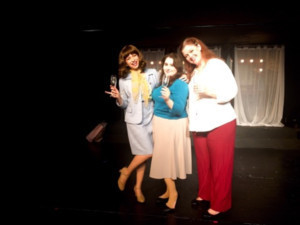Review: VANITIES at Elite Theatre Company

Plays that show characters changing through the years are some of the most challenging actors can experience. In the 1976 Off-Broadway play Vanities, author/playwright Jack Heifner focuses on three Texas cheerleaders, tracing their lives over an eleven-year period in three acts, from their heady pom-pom pumping high school days in 1963 to their sorority college years in turbulent 1968, and finally, a sobering reunion in 1974. Director Kimberly Demmary, herself a playwright, is familiar with the nuances in character development, and got the best out of the three actresses playing Joanne, Kathy, and Mary in this alternately giddy and sad production. Vanities concludes its run at the Elite Theatre Company in Oxnard, July 5-7.
The play begins in November 1963, so you know that the Kennedy assassination is going to figure into the story somewhere. Despite this foreboding in the audience, the characters on stage are oblivious of what is going on in the real world, more content with fretting over boys, striving to be the football queen, and preparing pep rallies. Kathy, played by Hayley Silvers, is the head cheerleader and the "organizer" of the trio, bubbly and giddy with a clipboard in her hands. Joanne, played by Catie Sayeg, is self-absorbed, in love with her steady boyfriend Ted, and not particularly keen on academics ("I don't care to learn anything!" she chirps.) Mary, played by Stephanie Rice, filling in for an ill Arden Smith, is carefree and freewheeling. Even when the JFK assassination is announced over the school intercom, nothing appears to phase the girls' narcissistic world view, instead, fretting about whether that night's football game would be canceled because of the tragedy. The trio seem pretty much alike in the first act, but there are hints of problems to come, and their personalities begin to diverge when Act II takes place five years later.
By 1968, the girls are still together, attending college and living in a sorority dorm room. But their personalities have progressed, which is where Sayeg, Silvers, and Rice's acting abilities take over. Joanne has turned into a prude, but still showcases her Southern belle ignorance. Kathy remains the organizer, who is busily planning the sorority's "Kappa Kapers" annual show, but a cloud is now seen over her head as she agonizes over her future. Mary has become a free-spirited, promiscuous party animal, the exact opposite of Joanne. Each has focused on a major, but as things turn out, none stick, and in the third act, which takes place in 1974, we see how they have all abandoned their tenuous career goals and have drifted into realms where none of them is really happy. Joanne has become a repressed suburban housewife, prone to getting tipsy, Mary runs an erotic boutique, and Kathy is a self-loathing former teacher who has never recovered from being jilted by her high school boyfriend.
What is fascinating about Vanities is how each actress retains traces of their characters' respective personality traits over the three acts, yet are dramatically different people by the time the play ends. Silvers is particularly good in portraying the manic-depressive Kathy, joyous and enthusiastic when she is planning something, but submerging into a deep depression when she is not ("I hate my life!" she wails in Act III.) Sayeg's Joanne is still happily vacuous and naive but we see a darker side of her. Married to her high school sweetheart, who has become an overworked lawyer, she really has no life of her own and is prone to drinking to excess. Mary's rebellious college years stemmed from a hatred of her domineering parents. "Were we lucky to be stupid or were we just stupid?" Kathy wonders, as she reflects back on their innocent high school years.
Special credit goes to Stephanie Rice, the show's managing producer and stage manager, who stepped into the role of Mary with only one rehearsal when Arden Smith came down with a sudden illness the day we saw the show. Even while being "on book" (holding her script throughout the play), Rice fully owns her character and matched Sayeg and Silvers in their well-honed performances.
The play calls for each character to begin the show with their backs to the audience, sitting at matching vanities. During each scene change, they remain on stage, changing costumes and hair styles behind translucent curtains, which the girls draw in unison at the start of each act.
Vanities is an intriguing look at how events in one's youth affect personalities in later years. If there is a villain in this show, it's the cookie-cutter education system of the '60s and '70s, which inadequately prepared each character for their respective futures, with none of the three girls having assumed fulfilling, productive lives for themselves.
*****************
Vanities concludes its run at the Elite Theatre Company in Oxnard on July 7. For dates and showtimes, see the VC On Stage Calendar.
Reader Reviews

Videos

